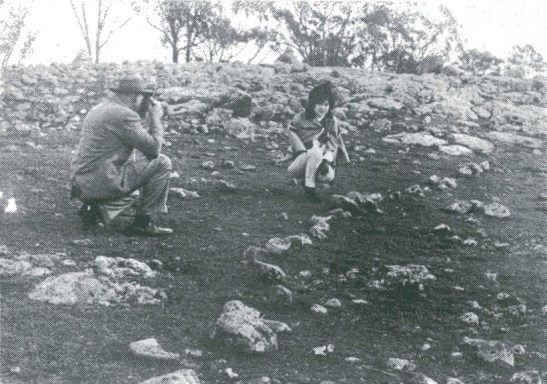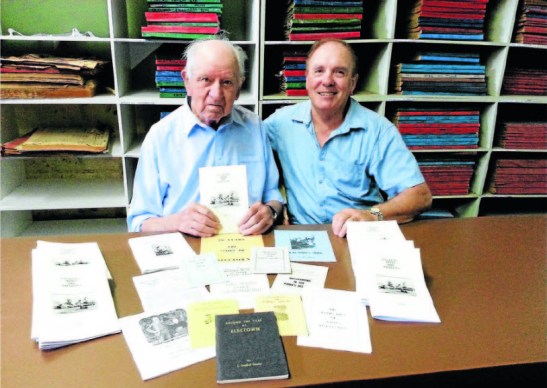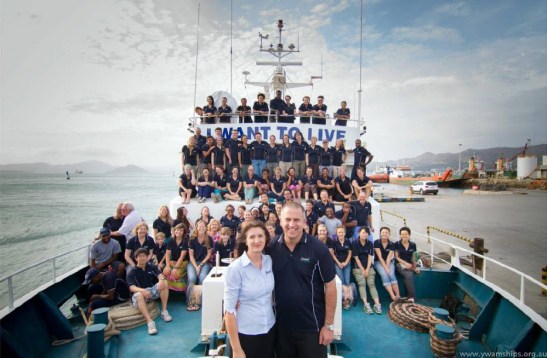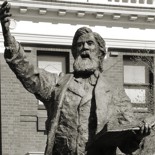Alectown – a town of gold and stars!
![The "Alectown Ace" posing next to his home town's sign. [Digital image]. (2016, April 28). Retrieved July 08, 2016, from http://www.parkeschampionpost.com.au/story/3875674/scott-poised-for-dream-run/](https://historyparkes.org/wp-content/uploads/2016/08/scott-at-alectown-sign.png?w=349&h=582)
The “Alectown Ace” posing next to his home town’s sign. [Digital image]. (2016, April 28). Retrieved July 08, 2016, from http://www.parkeschampionpost.com.au/story/3875674/scott-poised-for-dream-run/
History of Alectown
It is vital to acknowledge that the area known as Alectown was inhabited by indigenous Australians for thousands of years before it became named “Alectown”. Former Alectown resident and local historian, Len Unger, documented an interesting meeting between Major Mitchell and headman, Bultje, of the Wiradjuri nation. Mitchell gives an honest and positive account of meeting the locals while exploring through the area, including at Alectown:
The natives whom we met here were fine looking men, enjoying contentment and happiness within the precincts of their native woods. Their enjoyment seemed derived so directly from nature, that it almost excited a feeling of regret, that civilised men, enervated by luxury and all its concomitant diseases, should ever disturb the haunts of these rude happy beings.
Unger, Len (1995) page 4-5

Reproduction of a photograph of Aboriginal stone arrangements on Rocky View property. Rocky View was Len Unger’s home and part of this property now is home to “The Dish”. Photograph by Douglass Baglin sourced from Unger, Len A. Aboriginal Activity in the Parkes District. Parkes, N.S.W.: Parkes & District Historical Society, 1995. Print. page 2
Before the discovery of gold, white settlers realised that farming was a viable option in the area today known as Alectown. Former journalist of Parkes Champion Post, Bill Jayet, recorded the impact and legacy of the early farming families:
In 1865 Joseph Westcott moved from Victoria to the Alectown district north of Parkes, built a home on the property ‘Bridgewater’ and so became the district’s first farmer.
Today the name Westcott is synonymous not only with the Alectown farming community but throughout the Parkes Shire.
Properties such as Kadina Park, Glenbrook and Honey Springs all evolved as a result of that first settlement.
Neil Westcott, a fifth generation descendant of the pioneering Joseph Westcott, along with wife Alison, own and manage a combined 6,000 acres of land throughout the Alectown district from their property Swansea.
Jayet, B. (2014) page 7

This photograph appears on the inside front cover of Len Unger’s booklet Stories of Alectown – Historical – Humorous – Tragic. This reproduction is courtesy of Neil Westcott via Westcott Family Reunion Facebook page. It shows the original “Bridgewater” homestead in 1893 with fenced in yard. The original building was burnt down in 1931 and then rebuilt in 1935. Source: Neil Westcott’s family collection
However Joseph Westcott was not the only Victorian to move into the Alectown area. Another surname synonymous with Alectown – Unger – left the southern state for the “greener grass” of NSW’s Central West. When the gold boom brought thousands to the Parkes district, prospecters tried their luck in surrounding areas. Being just 15 miles north of Parkes (24 kilometres), gold was discovered and mentioned in dispatches in 1889.
![An article appearing in The Sydney Morning Herald detailing more people arriving in Alectown. Parkes and Peak Hill were more profitable than Alectown at the time. Source: [BY TELEGRAPH.] (FROM OUR CORRESPONDENTS.) FRESH DISCOVERIES ON THE PALMER GOLDFIELD. (1889, July 30). The Sydney Morning Herald (NSW : 1842 - 1954), p. 9. Retrieved April 21, 2017, from http://nla.gov.au/nla.news-article13746471](https://historyparkes.org/wp-content/uploads/2017/04/gold-found-at-alectown-smh-30-july-1889-page-9.jpg?w=547)
An article appearing in The Sydney Morning Herald detailing more people arriving in Alectown. Parkes and Peak Hill were more profitable than Alectown at the time. Source: [BY TELEGRAPH.] (FROM OUR CORRESPONDENTS.) FRESH DISCOVERIES ON THE PALMER GOLDFIELD. (1889, July 30). The Sydney Morning Herald (NSW : 1842 – 1954), p. 9. Retrieved April 21, 2017, from http://nla.gov.au/nla.news-article13746471

Snapshot of details of Alectown on the website of Geographical Names Board of New South Wales. Past names include Alecs Flat due to the three men who first prospected here – Alexander Cameron, Alexander Patton and Alexander Whitelaw. Source: Geographical Names Board of New South Wales website

The proclamation of the village of Alectown, as detailed in New South Wales Government Gazette Wednesday 18 September 1889. Although no longer used regularly, the County of Kennedy and the parish of Houston are somewhat prophetic in linking Alectown to the landing on the moon from President Kennedy’s NASA team at Houston! Source: Government Gazette Proclamations and Legislation (1889, September 18). New South Wales Government Gazette (Sydney, NSW : 1832 – 1900), p. 6564. Retrieved April 21, 2017, from http://nla.gov.au/nla.news-article222099343

A report of life in Alectown including the mass exodus at Christmas time and some weather information. Source: Australian Town and Country Journal Saturday 4 January 1890 page 13

Proposal to establish a public school at Alectown. Source: The Australian Star Saturday 4 January 1890 page 7

Reproduction of a photograph of the main street in Alectown in 1893. The view is looking north. This photograph is on the back cover of one of Len Unger’s historical booklets. The buildings are (from left to right) Barnett’s Butchery, McGee and Quinn’s Bakery, Bark Shop, Foster’s Original Store, Club House Hotel (with double gables), Bark Building used for school purposes in 1890, Miner’s Exchange Hotel, Fletcher’s Billiard Saloon. Source: Unger, L. A. (1983). Stories of Alectown: historical – humorous – tragic Parkes, N.S.W.: Parkes & District Historical Society
![This photograph is part of a special collection by Parkes Champion Post to celebrate the International Year of the Farming Family in 2014. In this photograph, Cliff Westcott (left) and Jack Mulligan are at 'Honey Springs' in 1971 with some of their Angora Goats. This joint venture breeding program started with one pure bred Angora Goat and feral goats from the Harvey Ranges. Source: Jayet, B. (2014, March 12). Cliff Westcott and Jack Mulligan at 'Honey Springs' in 1971 [Photograph found in Farming History dates back to 1865, but Neil and Alison now doing it their way, Parkes Champion Post, Parkes]. Retrieved April 26, 2017, from http://www.parkeschampionpost.com.au/story/2144583/farming-history-dates-back-to-1865-but-neil-and-alison-now-doing-it-their-way/#slide=7 (Originally photographed 2014, March 12)](https://historyparkes.org/wp-content/uploads/2017/04/cliff-westcott-and-jack-mulligan-at-honey-springs-alectown.jpg?w=547)
This photograph is part of a special collection by Parkes Champion Post to celebrate the International Year of the Farming Family in 2014. In this photograph, Cliff Westcott (left) and Jack Mulligan (father of Ken Mulligan) are at ‘Honey Springs’ in 1971 with some of their Angora Goats. This joint venture breeding program started with one pure bred Angora Goat and feral goats from the Harvey Ranges. Source: Jayet, B. (2014, March 12). Cliff Westcott and Jack Mulligan at ‘Honey Springs’ in 1971 [Photograph found in Farming History dates back to 1865, but Neil and Alison now doing it their way, Parkes Champion Post, Parkes]. Retrieved April 26, 2017, from http://www.parkeschampionpost.com.au/story/2144583/farming-history-dates-back-to-1865-but-neil-and-alison-now-doing-it-their-way/#slide=7 (Originally photographed 2014, March 12)
Like all farming towns, natural disasters will demonstrate their devastating impact at various times. This photograph is from the bushfire that engulfed Alectown on 30th November 2004. Source: Parkes Champion Post Monday June 26, 2006 page 3

Alectown has hosted international acts such as the Watoto Children’s Choir from Uganda. This photograph was taken at their concert at the Bush Cathedral belonging to Vision Ministries’ Mamre Farm. Source: Parkes Champion Post Wednesday July 29, 2015 page 5
Like many small country towns and villages, Alectown’s population has been on gradual decline with the occasional peaks over the years. In the 1947 Census, Alectown’s population was 194 (Source: ABS website). By the time of the next national Census, 1954, the town had boomed to 301 which coincidentally was the same number at the 1961 Census. The 1966 Census saw a change to the way statistics were recorded and only towns with one hundred persons or more were recorded. As Alectown didn’t feature in the 1966 Census, it can be presumed that its population was less than 100. According to ABS website on 2006 Census Alectown had a population of 201 (Source: ABS website) but the same website doesn’t include Alectown in its 2011 Census results – rather it is part of a larger section called Goonumbla with a population of 350.
The rise, fall and rise of the Parkes Shire population was a series of three blog posts published last year.
To read Part 1 1865 – 1945 click here
To read Part 2 1947 – 1971 click here
To read Part 3 The ABS Years 1976 – present click here
Some Alectown Legends
Scott Westcott – Olympic marathon man at age 40
Patience and perseverance are two virtues that Scott Westcott has in abundance. Scott’s Olympic dream began when he was a young boy chasing livestock on the family farm at Alectown. However the realisation of this dream took over 25 years – at the age of forty. Despite coming close on several attempts, Scott believed that the Olympic dream would remain a dream. A family birthday present – entry in the Berlin Marathon – renewed belief that dream could become reality, as Scott finished the marathon in Olympic qualifying time. Scott Westcott is one of eight former residents of the Parkes Shire to represent Australia at an Olympic games. The blog post on Scott Westcott’s incredible journey can be read here http://wp.me/p5OClA-Ga

Scott Westcott’s profile on the Australian Olympic Committee’s website. Scott finished the marathon in a time of 2:22:19 and finished 81st out of the 155 competitors. Source: Australian Olympic Committee website
Len Unger – centenarian historian

Len (at age 97 years old) in 2014 with nephew Don Unger and some of the books that he had researched and published. Photo: Parkes Champion Post website
Leonard Arthur Unger was the youngest of three boys and born on February 27, 1917 at Nurse Ethel Clara Job’s maternity hospital which was situated in at the end of Mitchell Street near the Parkes Showground. His parents were Alfred Berthold Herbert Unger and Pauline Selma Unger (née Salan). Len’s brothers were Herbert Wilhelm Carl Unger and Ernest Alfred Berthold Unger, who also shared the longevity genes. Herb lived to 101 years of age and Ern was 92 years old when he passed away.
Len grew up in Alectown, on the family farm called “Rocky View”. Len went to school in Alectown, travelling by horse and sulky there and back. Len recalls that in the small school at Alectown he was one of four boys called Len! When a fire burnt the family house down in 1992, Len moved to Parkes. He stayed in a flat until 2014 when he moved to his final home – as a resident at Rosedurante Aged Care Plus Centre.
One of Len’s passions was family and local history, and he has written many books on the subject including:
- Bushranging in the Parkes District
- Early Days on the Bogan
- The Town That Disappeared (The Story of McGuigans 1874-1876)
- Aboriginal Activity in the Parkes District
- On The Home Front
- Stories of Alectown – Historical – Humorous – Tragic
- Early Days of Western Motoring
- Unger Family in Australia 1860-1988
- A Brief Biography of Carl Erdmann Salan 1856-1932
- The Butler Murder Case (1896-1897)
- A History of Henry Parkes Museum & Pioneer Park Museum
- Panorama of Parkes 1817-1977
Len was also a contributor to other local history books such as Centenary of Parkes Shows 1880-1980; Unger Family Reunion (a book produced to celebrate the centenary of Unger family moving from Victoria to Alectown) and also Parkes 100 Years of Local Government (affectionately known by locals as “the blue book”)
All of the above books are available to read in Parkes Library’s Family & Local History Resource Room (they are reference books which means they cannot be borrowed)
[To read more about Rosedurnate including Parkes’ connection to Northern Ireland go to http://wp.me/p5OClA-m2]
![Photograph taken on the occasion of Len Unger's 100th birthday. Born February 27, 1917 Len has lived his whole life in the Parkes Shire. Starting at the family farm, Rocky Point then Talbot Street, Parkes and then Rosedurnate Aged Care Plus Centre. Source: Speelman, C. (2017, February 27). Century [Photograph found in Len Unger of Alectown turns 100, Parkes Champion Post, Parkes]. Retrieved April 26, 2017, from http://www.parkeschampionpost.com.au/story/4494353/len-was-determined-to-turn-100/ (Originally photographed 2017, February 27)](https://historyparkes.org/wp-content/uploads/2017/04/len-unger-100th-birthday.jpg?w=547)
Photograph taken on the occasion of Len Unger’s 100th birthday at Rosedurnate. Born February 27, 1917 Len has lived his whole life in the Parkes Shire. Starting at the family farm, Rocky View then Talbot Street, Parkes and finally Rosedurnate Aged Care Plus Centre. Source: Speelman, C. (2017, February 27). Century [Photograph found in Len Unger of Alectown turns 100, Parkes Champion Post, Parkes]. Retrieved April 26, 2017, from http://www.parkeschampionpost.com.au/story/4494353/len-was-determined-to-turn-100/ (Originally photographed 2017, February 27)
Ken Mulligan – the good neighbour
Growing up on the family farm at Alectown, young Ken probably didn’t expect his life to be based in north Queensland with regular trips to Papua New Guinea. However this is Ken Mulligan’s life today – even as this is being typed Ken is on a mission to PNG again.
Ken now lives in Townsville and is Managing Director of YWAM (Youth With A Mission). Ken is the son of Jack and Helen Mulligan, who both call Parkes home now. Ken and his wife Robyn (who came from Trewilga) have been in Townsville since 1992 and they are both responsible for the large number of volunteers carrying out valuable work locally in Townsville and in Papua New Guinea.
Such is the dedication of former Alectown lad Ken Mulligan that he has received several awards including 2008 Townsville Citizen of the Year and Order of Australia Medal in 2013.
To read more about Ken Mulligan’s incredible journey from Alectown to PNG via Townsville (and a few other places) click here.
To learn more about the work of YWAM click here

Being Alectown born and bred didn’t prevent Ken Mulligan gaining his sea legs! This photograph is of Ken and Robyn Mulligan on the YWAM ship which regularly sails to Papua New Guinea. Source: Parkes Champion Post website

This photo was taken in 1969 – at around the time that The Dish assisted NASA with the first manned moon landing. Even today it is still one of the most advanced telescopes of its kind. Image credit: CSIRO
The Dish
Another icon of Alectown is the radio telescope at Parkes Observatory, affectionately known as “The Dish”. The Dish is operated by the Commonwealth Scientific and Industrial Research Organisation (CSIRO). It was the brainchild of the then chief of CSIRO’s Radiophysics Laboratory, E.G. “Taffy” Bowen. Partially funded by two philanthropic organisations – the Carnegie Corporation and the Rockefeller Foundation – construction was completed on 31st October 1961. Still in operation today, The Dish can lay claim to several accomplishments:
- participated in the Apollo moon missions including the moon landing of 1969;
- has several times held the record for discovering the most distant object known in the Universe;
- discovered over half the known number of pulsars;
- played a part in rescuing the Apollo 13 mission;
- one of few scientific instruments to have lasted over 50 years;
- lauded as the most successful scientific instrument constructed in Australia;
- featured in a major Australian film, The Dish, made by Working Dog productions and the top grossing film in Australia in 2000;
- used in album cover art for progressive rock artist Steve Hillage’s LP “Motivation Radio”;
- features in music video for 2002 Bon Jovi single “Everyday”
To read more about The Dish head to here and here
This slideshow requires JavaScript.

This poem about the rise and fall of Alectown was written by C Campbell Crowley and is the last contribution to his book Around The Year At Alectown. It is a concise history of Alectown’s early days and highlights the community spirit. The “Annuals” were organised sporting activities and included gymkhanas, football, cricket amongst other things. Also contained is mining vocabulary such as “rush”, “diggings” and “petered out”. Source: Crowley, C. C. (1959). Around The Year At Alectown (Vol. 4). Melbourne: C.C. Crowley
Parkes Shire Library would like to thank the following people and organisations for their assistance in making this post possible:
- Len Unger;
- Councillor Neil Westcott;
- Councillor Bill Jayet;
- Trove;
- Parkes Champion Post and Christine Speelman;
- Scott Westcott;
- Ian and Marion Unger;
- Ken Mulligan and the team at YWAM Townsville;
- the staff and residents of Rosedurnate Aged Care Plus Centre;
- staff and volunteers at Parkes Shire Library, especially Leon Madden
If you have stories or memories that you are willing to share about Alectown please contact Parkes Shire Library via library@parkes.nsw.gov.au so that they can be shared and kept for posterity on this blog. Alternatively you may leave comments on this page.
REFERENCE LIST
- Scott Westcott will learn if his Olympic dream will come true later today [Digital image]. (2016, April 28). Retrieved July 08, 2016, from http://www.parkeschampionpost.com.au/story/3875674/scott-poised-for-dream-run/
- Australian Bureau of Statistics. (2007, October 25). 2006 Census QuickStats: Alectown. Retrieved April 19, 2017, from http://www.censusdata.abs.gov.au/census_services/getproduct/census/2006/quickstat/SSC16043?opendocument&navpos=220
- Unger, Len A. Aboriginal Activity in the Parkes District. Parkes, N.S.W.: Parkes & District Historical Society, 1995. Print. page 2
- Joseph Westcott’s “Bridgewater” Homestead 1893 [Personal photograph taken in Alectown]. (n.d.). Sourced from Neil Westcott via Westcott Family Reunion Facebook page
- Jayet, B. (2014, March 12). Farming history dates back to 1865, but Neil and Alison now doing it their way. Parkes Champion Post, p. 7. Retrieved April 26, 2017, from http://www.parkeschampionpost.com.au/story/2144583/farming-history-dates-back-to-1865-but-neil-and-alison-now-doing-it-their-way/
- [BY TELEGRAPH.] (FROM OUR CORRESPONDENTS.) FRESH DISCOVERIES ON THE PALMER GOLDFIELD. (1889, July 30). The Sydney Morning Herald (NSW : 1842 – 1954), p. 9. Retrieved April 21, 2017, from http://nla.gov.au/nla.news-article13746471
- Geographical Name Board of New South Wales. (n.d.). Extract. Retrieved April 20, 2017, from http://www.gnb.nsw.gov.au/place_naming/placename_search/extract?id=MnjLWy
- Government Gazette Proclamations and Legislation (1889, September 18). New South Wales Government Gazette (Sydney, NSW : 1832 – 1900), p. 6564. Retrieved April 21, 2017, from http://nla.gov.au/nla.news-article222099343
- Alectown. (1890, January 4). Australian Town and Country Journal (Sydney, NSW : 1870 – 1907), p. 13. Retrieved April 24, 2017, from http://nla.gov.au/nla.news-article71106285
- GOVERNMENT GAZETTE. (1890, January 4). The Australian Star (Sydney, NSW : 1887 – 1909), p. 7. Retrieved April 24, 2017, from http://nla.gov.au/nla.news-article230604526
- Jayet, B. (2014, March 12). Cliff Westcott and Jack Mulligan at ‘Honey Springs’ in 1971 [Photograph found in “Farming History dates back to 1865, but Neil and Alison now doing it their way”, Parkes Champion Post, Parkes]. Retrieved April 26, 2017, from http://www.parkeschampionpost.com.au/story/2144583/farming-history-dates-back-to-1865-but-neil-and-alison-now-doing-it-their-way/#slide=7 (Originally photographed 2014, March 12)
- Jayet, B. (n.d.). A scene from devastating Alectown bushfire [Photograph found in Alectown fires inquiry today, Parkes Champion Post, Parkes]. In Alectown fires inquiry today (Monday, June 26, 2006 ed., p. 3). Parkes, NSW: Parkes Champion Post. (Originally photographed 2004, November 30)
- Renee Powell. (2015, July 28). Watoto wows Mamre | GALLERY. Retrieved May 16, 2017, from http://www.parkeschampionpost.com.au/story/3240949/watoto-wows-mamre-gallery/
- Wilson, Commonwealth Statistician, R. (1947). Census of the Commonwealth of Australia: Part VIII Population and Occupied Dwellings in Localities (p. 497) (Australia, Commonwealth Bureau of Census and Statistics). Canberra, ACT: Commonwealth Government Printer. Retrieved May 19, 2017, from http://www.ausstats.abs.gov.au/ausstats/free.nsf/0/2F3A37515796B189CA25784100193B4B/$File/1947%20Census%20-%20Volume%20I%20-%20Part%20VIII%20Population%20and%20Occupied%20Dwellings%20in%20Localities.pdf
- Australian Bureau of Statistics. (2007, October 25). 2006 Census QuickStats: Alectown. Retrieved May 19, 2017, from http://www.censusdata.abs.gov.au/census_services/getproduct/census/2006/quickstat/SSC16043?opendocument&navpos=220
- Unger, L. A. (1983). Stories of Alectown: historical – humorous – tragic. Parkes, N.S.W.: Parkes & District Historical Society.
- Australian Olympic Committee. (n.d.). Scott Westcott. Retrieved May 11, 2017, from http://corporate.olympics.com.au/athlete/scott-westcott
- Byrne, R. (2017, April 23). Len Unger with nephew Don Unger and some of the books he has produced [Photograph found in Parkes Champion Post, Parkes]. Retrieved May 19, 2017, from http://www.parkeschampionpost.com.au/story/2233756/len-still-going-strong-at-97/#slide=2 (Originally photographed 2014, April 23)
- Speelman, C. (2017, February 26). Len was determined to turn 100. Retrieved April 26, 2017, from http://www.parkeschampionpost.com.au/story/4494353/len-was-determined-to-turn-100/
- Australian Community Media – Fairfax Media. (2013, October 01). Ken’s amazing contribution. Retrieved May 19, 2017, from http://www.parkeschampionpost.com.au/story/1814570/kens-amazing-contribution/
- CSIRO (2014, September 19) CSIRO’s Parkes Radio Telescope with moon in the background [Photograph found in CSIRO Science Images] Retrieved May 19, 2017 from https://upload.wikimedia.org/wikipedia/commons/0/00/CSIRO_ScienceImage_4350_CSIROs_Parkes_Radio_Telescope_with_moon_in_the_background/jpg (Originally photographed 1969)
- Muller, N. (2011, October 31). On this Day: ‘The Dish’ radio telescope opens. Retrieved May 18, 2017, from http://www.australiangeographic.com.au/blogs/on-this-day/2011/10/on-this-day-the-dish-radio-telescope-opens/
- Robertson, P. (2010, February 08). 40 Years of The Dish. Retrieved May 18, 2017, from http://www.abc.net.au/science/articles/2010/02/09/2814525.htm
- CSIRO. (2011, October 30). The Dish 1961 opening [Photograph found in On this Day: ‘The Dish’ radio telescope opens, Australian Geographic]. In N. Muller (Author). Retrieved May 19, 2017, from http://www.australiangeographic.com.au/blogs/on-this-day/2011/10/on-this-day-the-dish-radio-telescope-opens/ (Originally photographed 1961, October 31)
- CSIRO. (n.d.). The Parkes radio telescope in central western NSW [Photograph found in On this Day: ‘The Dish’ radio telescope opens, Australian Geographic]. Retrieved May 19, 2017, from http://www.australiangeographic.com.au/blogs/on-this-day/2011/10/on-this-day-the-dish-radio-telescope-opens/
- England, Wayne (2017, April 11). The Dish at night [Photograph found in Parkes Shire Council]. Retrieved April 21, 2017, from https://t.co/iACtBMoG6i
- Sarkissian, John (2004, December 30) The Parkes radio telescope [Photograph from CSIRO Parkes Observatory collection] Retrieved May 19, 2017 from https://commons.wikimedia.org/wiki/File:Parkes.arp.750pix.jpg (Originally photographed 2003, December)
- O Mealoid, Michael (2011, June 17) Cover art for the album Motivation Radio by Steve Hillage [Photograph found in Michael O Mealoid personal collection] Retrieved May 19, 2017 from https:en.wikipedia.org/wiki/Motivation_Radio#/media/File:Motivation_Radio_LP_cover.jpg (Originally photographed 2008, July 10)
- Photograph still from “Everyday” music video BonJoviVEVO. (2009, June 16). Retrieved May 18, 2017, from https://www.youtube.com/watch?v=870-_Fa5bgo
- Crowley, C. C. (1959). Around The Year At Alectown (Vol. 4). Melbourne: C.C. Crowley.

